
The Ericaceae are a family of flowering plants, commonly known as the heath or heather family, found most commonly in acidic and infertile growing conditions. The family is large, with c. 4250 known species spread across 124 genera, making it the 14th most species-rich family of flowering plants. The many well known and economically important members of the Ericaceae include the cranberry, blueberry, huckleberry, rhododendron, and various common heaths and heathers.

Vaccinium vitis-idaea, the lingonberry, partridgeberry, mountain cranberry or cowberry, is a small evergreen shrub in the heath family Ericaceae, that bears edible fruit. It is native to boreal forest and Arctic tundra throughout the Northern Hemisphere, from Europe and Asia to North America. Lingonberries are picked in the wild and used to accompany various dishes, primarily in the Nordics. Commercial cultivation is undertaken in the U.S. Pacific Northwest and in the Netherlands.
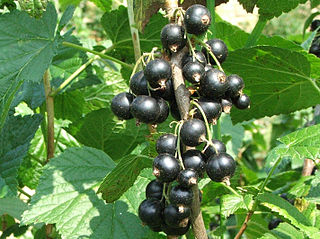
The blackcurrant, also known as black currant or cassis, is a deciduous shrub in the family Grossulariaceae grown for its edible berries. It is native to temperate parts of central and northern Europe and northern Asia, where it prefers damp fertile soils. It is widely cultivated both commercially and domestically.
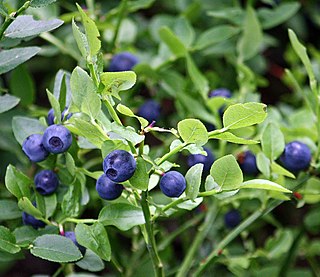
Bilberries, or in Europe blueberries, are a primarily Eurasian species of low-growing shrubs in the genus Vaccinium, bearing edible, dark blue berries. The species most often referred to is Vaccinium myrtillus L., but there are several other closely related species.

Arctostaphylos uva-ursi is a plant species of the genus Arctostaphylos widely distributed across circumboreal regions of the subarctic Northern Hemisphere. Kinnikinnick is a common name in Canada and the United States. Growing up to 30 centimetres in height, the leaves are evergreen. The flowers are white to pink and the fruit is a red berry.
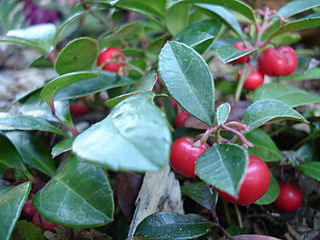
Gaultheria procumbens, also called the eastern teaberry, the checkerberry, the boxberry, or the American wintergreen, is a species of Gaultheria native to northeastern North America from Newfoundland west to southeastern Manitoba, and south to Alabama. It is a member of the Ericaceae.

Solanum nigrum, the European black nightshade or simply black nightshade or blackberry nightshade, is a species of flowering plant in the family Solanaceae, native to Eurasia and introduced in the Americas, Australasia, and South Africa. Ripe berries and cooked leaves of edible strains are used as food in some locales, and plant parts are used as a traditional medicine. Some other species may also be referred to as "black nightshade".
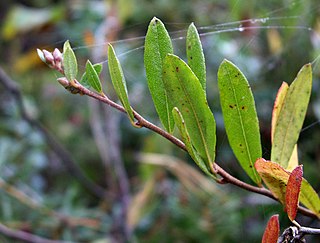
Chamaedaphne calyculata, known commonly as leatherleaf or cassandra, is a perennial dwarf shrub in the plant family Ericaceae and the only species in the genus Chamaedaphne. It is commonly seen in cold, acidic bogs and forms large, spreading colonies.

Empetrum nigrum, crowberry, black crowberry, or, in western Alaska, blackberry, is a flowering plant species in the heather family Ericaceae with a near circumboreal distribution in the Northern Hemisphere. It is usually dioecious, but there is a bisexual tetraploid subspecies, Empetrum nigrum subsp. hermaphroditum, which occurs in more northerly locations and at higher altitude.
Olaf Hagerup was a Danish botanist. He studied botany at the University of Copenhagen from 1911 under the professors Eugenius Warming, Christen C. Raunkiær, L. Kolderup Rosenvinge og W. Johannsen. He took his Ph.D. from the same university in 1930. From 1934 to 1960, he was superintendent at the Botanical Museum of the University of Copenhagen.

Myrica cerifera is a small evergreen tree or large shrub native to North and Central America and the Caribbean. Its common names include southern wax myrtle, southern bayberry, candleberry, bayberry tree, and tallow shrub. It sees uses both in the garden and for candlemaking, as well as a medicinal plant.
The Structure and Biology of Arctic Flowering Plants is a classical scientific work on morphology and anatomy in relation to the harsh arctic environment. It was initiated by Eugenius Warming and conducted by himself and a suite of students and colleagues at the University of Copenhagen.

Greenlandic cuisine is traditionally based on meat from marine mammals, birds, and fish, and normally contains high levels of protein. Since colonization and the arrival of international trade, the cuisine has been increasingly influenced by Danish, British, American and Canadian cuisine. During the summer when the weather is milder, meals are often eaten outdoors.

Chamaenerion latifolium is a species of flowering plant in the evening primrose family known by the English common names dwarf fireweed and river beauty willowherb. It has a circumboreal distribution, appearing throughout the northern regions of the Northern Hemisphere, including subarctic and Arctic areas such as snowmelt-flooded gravel bars and talus, in a wide range of elevations. This is a perennial herb growing in clumps of leaves variable in size, shape, and texture above a woody caudex. The leaves are 1 to 10 centimeters long, lance-shaped to oval, pointed or rounded at the tips, and hairy to hairless and waxy. The inflorescence is a rough-haired raceme of nodding flowers with bright to deep pink, and occasionally white, petals up to 3 centimeters long. Behind the opened petals are pointed sepals. The fruit is an elongated capsule which may exceed 10 centimeters in length.

Empetrum rubrum, known as red crowberry or diddle-dee, is a species of plant in the family Ericaceae with a distributional range in Chile from Talca (35°S) to Cape Horn (55°S); in areas of adjacent Argentina; in the Falkland Islands; and in Tristan da Cunha. One of its northernmost natural growing places is Laguna del Maule. In Chile this species often grows in high altitude areas close to the tree line and can tolerate alpine conditions such as strong winds and high sun exposure. In the Falkland Islands it is the dominant species across large areas of lowland and upland dwarf shrub heath, and is referenced in the islands' unofficial national anthem. Its fruits are edible.
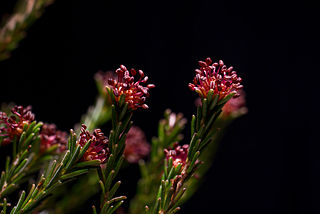
Corema conradii is a species of flowering plant in the heath family known by the common name broom crowberry. It is native to eastern North America, where it has a disjunct distribution, occurring intermittently from Nova Scotia to Massachusetts, in the Shawangunk Mountains of New York, and in the Pine Barrens of New Jersey. Studies indicate that the plant might be a hybrid between ancestral populations of Corema album and Ceratiola.
Empetrum eamesii, common name purple crowberry, is a plant native to eastern Canada and the northeastern United States. It has been reported from sand dunes, rocky outcrops, and alpine heath in Québec, Nova Scotia, Prince Edward Island, Maine, New Hampshire, Vermont, New York State, the Upper Peninsula of Michigan, Minnesota, Newfoundland & Labrador and St. Pierre & Miquelon.

Berberis bealei, also known as leatherleaf mahonia, Beale's barberry, or Oregon grape, is a species of evergreen shrub native to mainland China. The species has been regarded as the same species as Berberis japonica, native to Taiwan, but the two differ consistently in certain floral and leaf characters. Both species are widely cultivated in many countries as ornamentals. Berberis bealei has reportedly escaped cultivation and become established in the wild in scattered places in the south-eastern United States from Arkansas to Florida to Delaware.

Myrica caroliniensis is a shrub or small tree native to the coast and coastal plains of southeastern North America. Its common names include bayberry, southern bayberry, pocosin bayberry, and evergreen bayberry. It sees uses in the garden and for candlemaking, as well as a medicinal plant.
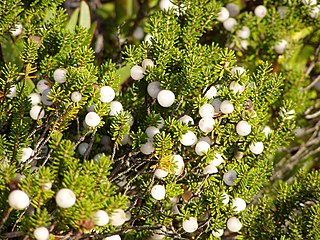
Corema album, the Portuguese crowberry ; Spanish: camarina, is a species of flowering plant in the family Ericaceae endemic to the Iberian Peninsula, Aquitaine, and the Azores (sub-species), where it may also be considered a different species. Its white berries are known to have been consumed by people in the Iberian Peninsula at least since the Middle-Ages. The only other species of the same genus is Corema conradii, found in North America.



















